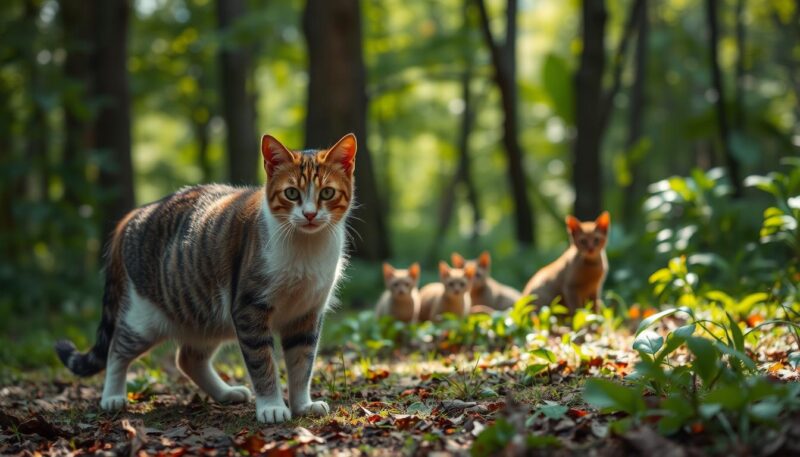Did you know that about 60-100 million feral cats roam the United States? This number is much higher than stray cats. Knowing the difference between feral and stray cats is crucial for animal lovers. Feral cats live in colonies without human contact, while stray cats often miss their human friends.
Understanding these differences helps us care for them better. It also helps us support effective ways to manage and care for both groups.
In this article, we’ll explore the behaviors, origins, and survival tactics of these cats. This knowledge can help you support their welfare. Knowing the differences is key to improving their lives.
Understanding the Nature of Feral Cats and Stray Cats
It’s important to understand the nature of feral and stray cats to treat them humanely. Both are cats, but their lives and interactions with humans are different. This section will look at their definitions and the key behavioral differences. These differences help us know how to best help them.
What is a Feral Cat?
Feral cats are born and raised outside, often without human contact. This makes them independent and cautious around people. Dr. Jonathan Roberts says feral cats live in colonies and use their instincts to survive. They act out of caution and self-preservation.
What is a Stray Cat?
Stray cats are domestic cats that got lost or abandoned. They have had human contact before. This makes them more friendly and looking for human company. Their behavior and way of living change because of this.
Behavioral Differences
Knowing how feral and stray cats behave is key to helping them. Feral cats are scared and stay away from humans and new places. Stray cats, however, might come to people for food or comfort. This shows their past with humans.

Feral Cats vs Stray Cats: Key Differences
Looking into the differences between feral and stray cats shows us their unique backgrounds, living situations, social behaviors, and health. Knowing these differences helps us better care for them and manage their numbers.
Origins and Living Conditions
Feral cats usually come from colonies in the wild. They learn to survive on their own, often in old buildings or bushes. Stray cats, however, come from homes where they were once loved by people. They end up outside, facing new challenges.
Feral cats are great at hunting and finding food. Stray cats might find it harder to adjust. Feral cats live well in the wild, but stray cats need a safer place to thrive.
Socialization and Interaction
Feral cats don’t really know people and might get scared when they see them. Stray cats, though, love people and act friendly because they used to live with them.
This difference in how they act around people and animals means feral cats need a lot of help to live with humans.
Health and Survival Skills
Both feral and stray cats face health problems, but feral cats are more resourceful. They deal with tough situations better. Stray cats, however, might get anxious and have more health issues because they rely on people to help them.
Understanding feral and stray cats helps us see what they need to live better lives. This knowledge guides efforts to improve their well-being.

Conclusion
Feral cats and stray cats have big differences that many people miss. Knowing these differences helps us help these cats better. Feral cats live wild and need community help to survive. Programs like Trap-Neuter-Return (TNR) are key. They keep feral cat numbers in check and make their lives better.
Stray cats, on the other hand, have had human contact. They might need more help to live with people again. This could mean building a bond with them and giving them the care they need. By understanding what each group needs, we can help them in meaningful ways.
Learning more about feral and stray cats helps us make better choices in our communities. This is important for a healthy place where cats and people can live together well. Recognizing their different needs helps the cats and makes our communities stronger.

